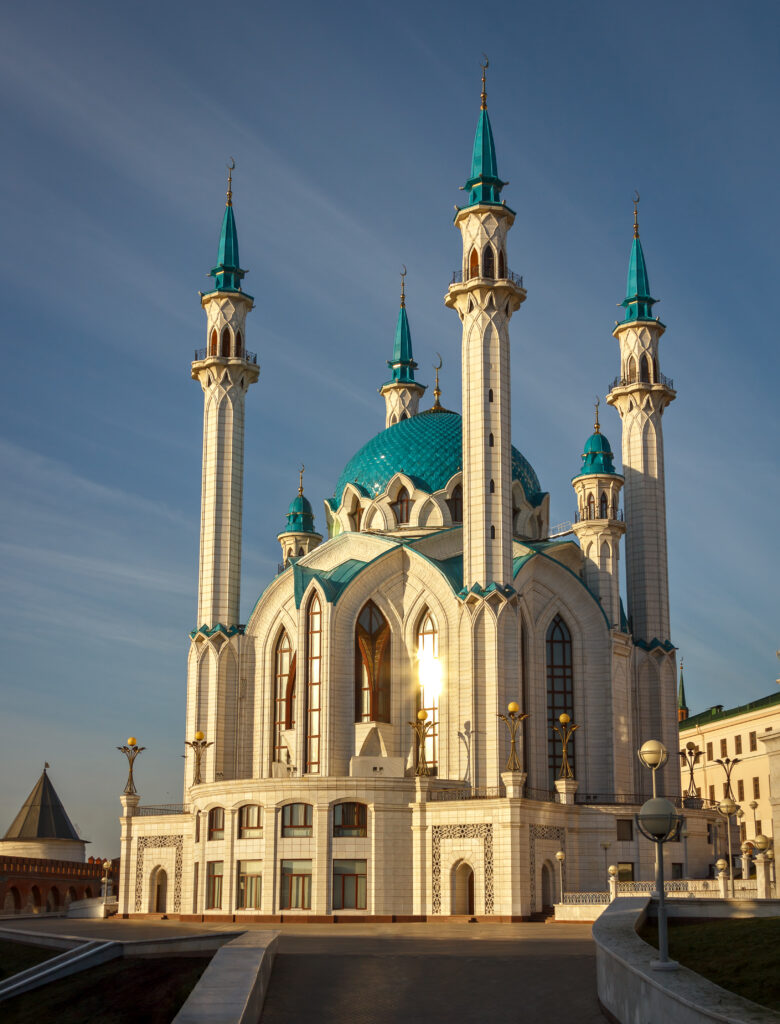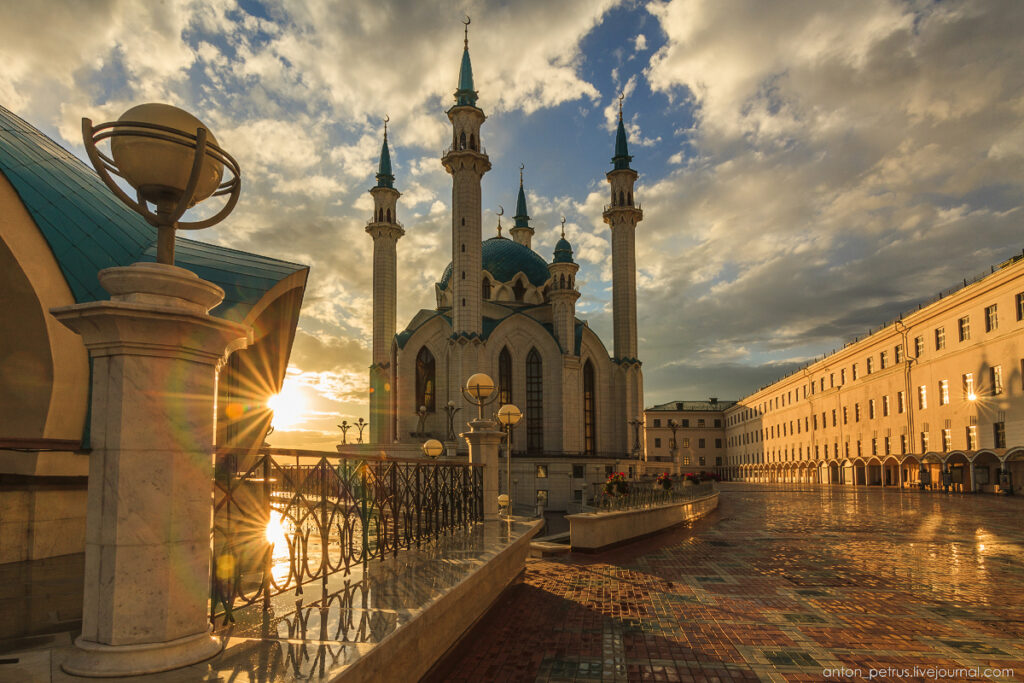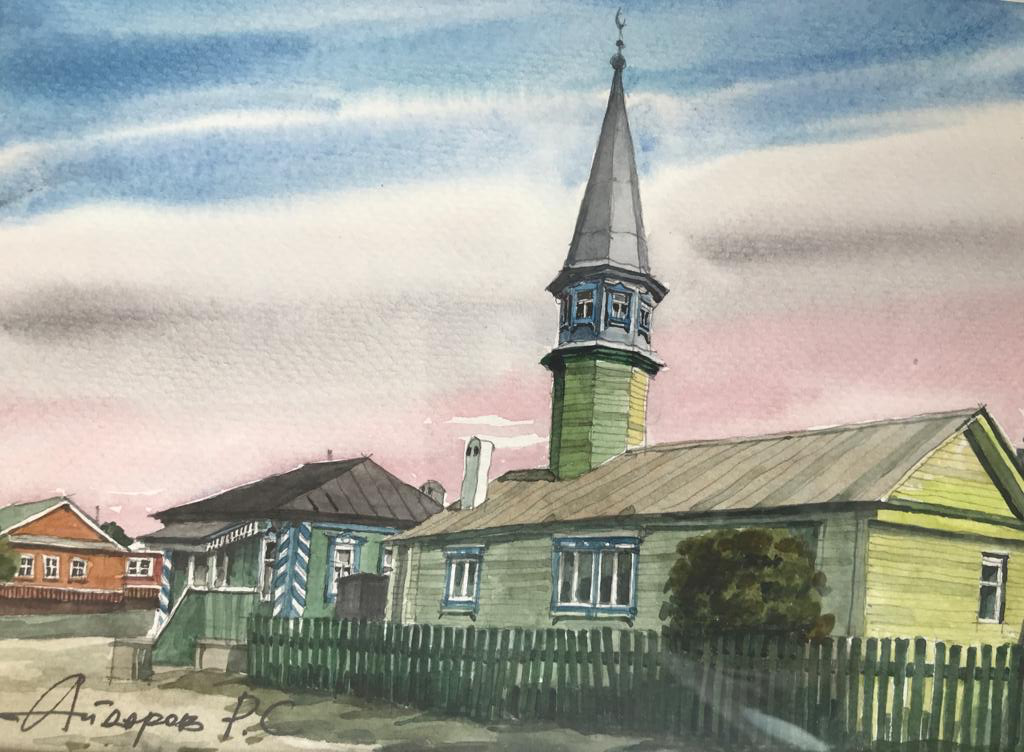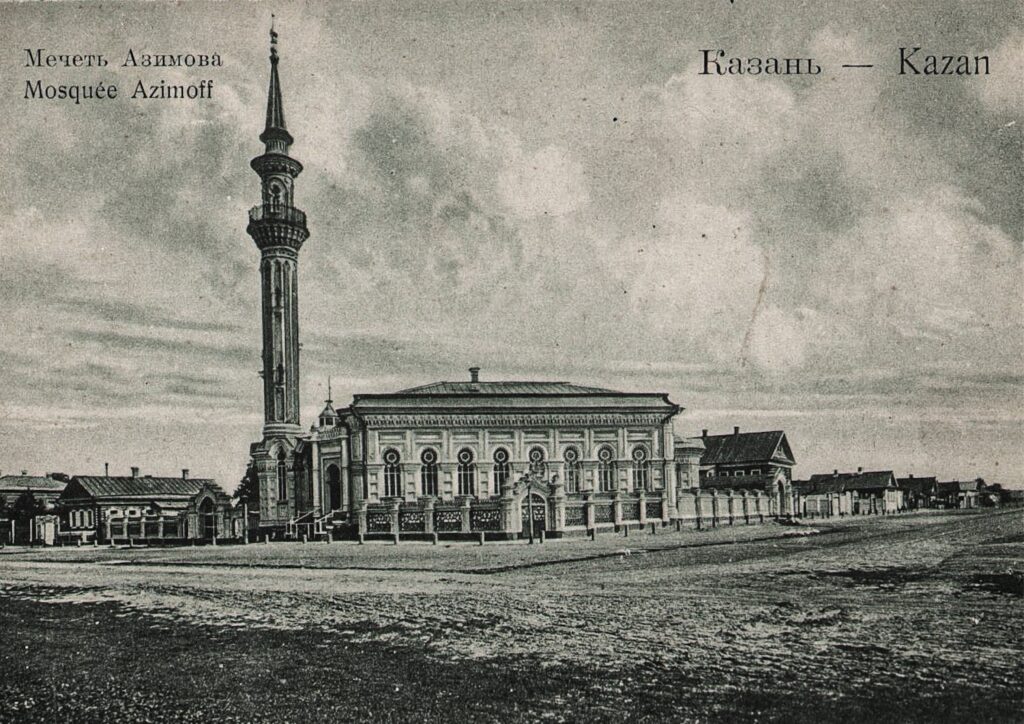Kul Sharif Mosque
August 3


The construction of the mosque “Kul-Sharif” began in 1996, according to the plan of the author’s group of architects from the firm “Tatinvestgrazhdanproekt” A.V. Golovin, A.I. Iskhakov, I.F. Saifullin, A.G. Sattarov, M.V. Safaronov, S.P. Shakurov.
The mosque was built for the 1000th anniversary of Kazan, which was celebrated in 2005. It has become one of the symbols of modern Kazan.
The facades of the mosque are formed by eight intersecting lancet arches. They are framed with ayats (verses) of the Quran carved in marble. High lancet windows are inscribed in the walls.
The main dome, 36 meters high and 17.5 meters in diameter, according to the authors of the project, resembles the so-called “Kazan Cap” – the crown of the Kazan khans, which is now kept in the Armory of the Moscow Kremlin. Tulip-shaped windows cut through the dome. This flower is an ancient Bulgar symbol of revival and prosperity.
Kul Sharif Mosque has four large minarets 57 meters high, two small minarets and two more decorative minarets decorating the main entrance portal.
The minarets are crowned with crescents, the sharp edges of which point towards Mecca, where all mosques of the world are oriented. This direction is called qibla (literally translated as “that which is opposite”).
Kul Sharif Mosque was built remembering one of the most legendary monuments of Khan’s Kazan – the multi-towered cathedral mosque. It amazed everyone not only by its splendor, elegance and beauty, but also by its size. All the population of Kazan gathered here on Fridays and ceremonies of enthronement of khans took place. At this mosque a spiritual school-madrasah was founded, a rich library was collected. In the XVI century it was the center of religious enlightenment of the entire Middle Volga region.
The imam of that ancient mosque was Seyid Kul Sharif, a descendant of the Prophet Muhammad, an influential statesman and religious figure, a skillful politician, diplomat, and even a poet. After the ascension of Yediger Khan to the throne of Kazan, Kul Sharif became a member of the government and actively participated in the daily affairs of the khanate.
But the era in which Seyid Kul Sharif lived was a tragic time of the Kazan Khanate’s movement towards its demise. During the siege of Kazan by Ivan the Terrible’s troops, Kul Sharif led the defense of the city in one of the sections. At the last stage of the assault on the walls of the cathedral mosque there were fierce battles, during which Imam Kul Sharif, together with his shakirds (students of madrasah) died. The memory of the legendary Kazan mosque and its imam has been preserved for centuries.
In November 1995, the first president of the Republic of Tatarstan, Mintimer Shaimiev, signed a decree to recreate a memorial mosque on the territory of the Kremlin “to preserve historical continuity”.
Many architects, not only from Russian cities, but also from Lebanon, Turkey, and Finland sent their works to the open competition for the best mosque project announced in the same year.
The final design combined the intentions of several contestants.
Since only few descriptions of the ancient mosque have survived, the modern Kul Sharif cannot be considered an exact copy of the disappeared monument. It is rather a symbol of the revival of national and religious traditions of the Tatar people.
The mosque was built for the 1000th anniversary of Kazan, which was celebrated in 2005. It has become one of the symbols of modern Kazan.
The facades of the mosque are formed by eight intersecting lancet arches. They are framed with ayats (verses) of the Quran carved in marble. High lancet windows are inscribed in the walls.
The main dome, 36 meters high and 17.5 meters in diameter, according to the authors of the project, resembles the so-called “Kazan Cap” – the crown of the Kazan khans, which is now kept in the Armory of the Moscow Kremlin. Tulip-shaped windows cut through the dome. This flower is an ancient Bulgar symbol of revival and prosperity.
Kul Sharif Mosque has four large minarets 57 meters high, two small minarets and two more decorative minarets decorating the main entrance portal.
The minarets are crowned with crescents, the sharp edges of which point towards Mecca, where all mosques of the world are oriented. This direction is called qibla (literally translated as “that which is opposite”).
Kul Sharif Mosque was built remembering one of the most legendary monuments of Khan’s Kazan – the multi-towered cathedral mosque. It amazed everyone not only by its splendor, elegance and beauty, but also by its size. All the population of Kazan gathered here on Fridays and ceremonies of enthronement of khans took place. At this mosque a spiritual school-madrasah was founded, a rich library was collected. In the XVI century it was the center of religious enlightenment of the entire Middle Volga region.
The imam of that ancient mosque was Seyid Kul Sharif, a descendant of the Prophet Muhammad, an influential statesman and religious figure, a skillful politician, diplomat, and even a poet. After the ascension of Yediger Khan to the throne of Kazan, Kul Sharif became a member of the government and actively participated in the daily affairs of the khanate.
But the era in which Seyid Kul Sharif lived was a tragic time of the Kazan Khanate’s movement towards its demise. During the siege of Kazan by Ivan the Terrible’s troops, Kul Sharif led the defense of the city in one of the sections. At the last stage of the assault on the walls of the cathedral mosque there were fierce battles, during which Imam Kul Sharif, together with his shakirds (students of madrasah) died. The memory of the legendary Kazan mosque and its imam has been preserved for centuries.
In November 1995, the first president of the Republic of Tatarstan, Mintimer Shaimiev, signed a decree to recreate a memorial mosque on the territory of the Kremlin “to preserve historical continuity”.
Many architects, not only from Russian cities, but also from Lebanon, Turkey, and Finland sent their works to the open competition for the best mosque project announced in the same year.
The final design combined the intentions of several contestants.
Since only few descriptions of the ancient mosque have survived, the modern Kul Sharif cannot be considered an exact copy of the disappeared monument. It is rather a symbol of the revival of national and religious traditions of the Tatar people.


